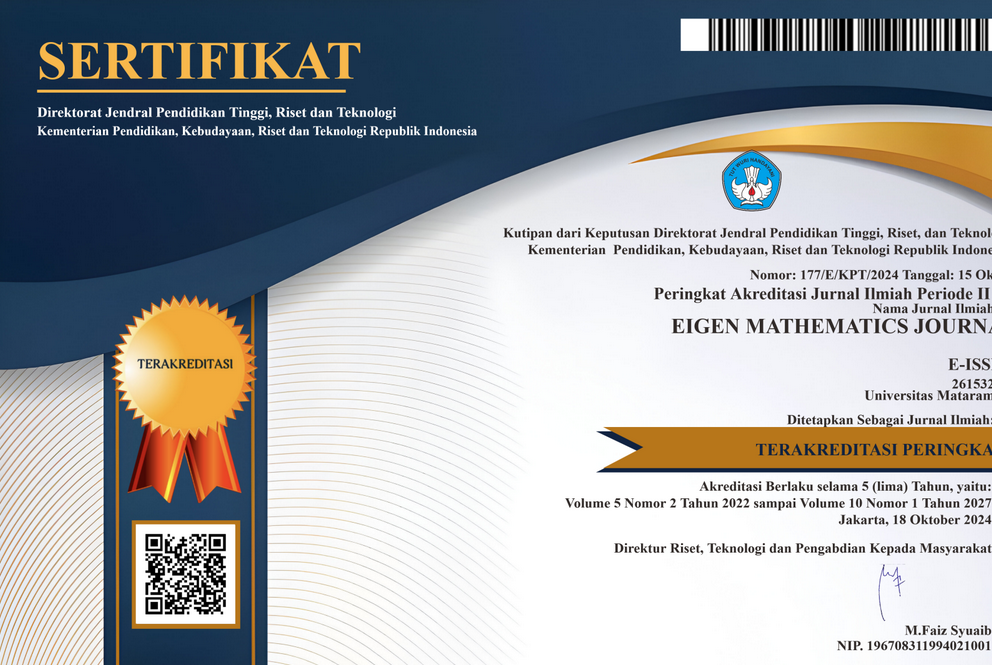Classification of Poverty Status using the Random Forest Algorithm
DOI:
https://doi.org/10.29303/emj.v5i1.133Keywords:
Poverty, Mean Decrease Accuracy, Random ForestAbstract
Poverty is a fundamental problem because it deals with the basic needs of society. In NTB Province, many households are living below the poverty line. One reason is that the government's efforts to reduce poverty are not optimal. Therefore, it is necessary to classify the factors that affect the poverty level so it can be used as a reference in making policies to reduce poverty. One of the classification methods is the Random Forest method. The Random Forest method with the optimal mtry and ntree scores, i.e., and , respectively, obtained an accuracy rate of 81.3%. This means that the accuracy of the Random Forest classification method for this data is very good. The income variable is the most influential factor in determining poverty status based on Random Forest analysis, with a Mean Decrease Accuracy score of 23.92%. It has the highest Mean Decrease Accuracy value among other attribute variables.References
Breiman, L., & Ihaka, R. (1984). Nonlinear discriminant analysis via scaling and ACE. Department of Statistics, University of California Davis One Shields Avenue.
Christy, E., & Suryowati, K. (2021). Analisis Klasifikasi Status Bekerja Penduduk Daerah Istimewa Yogyakarta Menggunakan Metode Random Forest. Jurnal Statistika Industri dan Komputasi, 6(1), 69-76.
Ferezagia, D. V. (2018). Analisis Tingkat Kemiskinan di Indonesia. Jurnal Sosial Humaniora Terapan, 1(1), 1–6.
Gorunescu, F. (2011). Data Mining: Concepts, models and techniques (Vol. 12). Springer Science & Business Media.
Jatmiko, Y. A., Padmadisastra, S., & Chadidjah, A. (2019). Analisis Perbandingan Kinerja Cart Konvensional, Bagging Dan Random Forest pada Klasifikasi Objek: Hasil Dari Dua Simulasi. Media Statistika, 12(1), 1.
Juliannisa, I. A., & Siswantini, T. (2019). Improving Human Development Index (HDI) by Illiteracy Eradication (Case Study in Cibadak Village). Jurnal Samudra Ekonomi Dan Bisnis, 11(1), 29–42.
KBBI. (2022). Kamus Besar Bahasa Indonesia (KBBI). https://kbbi.kemdikbud.go.id/
Lewis, R. J. (2000). An Introduction to Classification And Regression Tree (CART) Analysis. Annual Meeting of the Society for Academic Emergency Medicine in San Francisco, California, 14.
Mauludiyah, K. (2020). Klasifikasi Indeks Pembangunan Manusia Kabupaten/Kota di Indonesia Menggunakan Metode Random Forest. Doctoral Dissertation, Muhammadiyah University, Semarang.
Mayadewi, P., & Rosely, E. (2015). Prediksi Nilai Proyek Akhir Mahasiswa Menggunakan Algoritma Klasifikasi Data Mining. SESINDO.
Muflikhah, L., Mahmudy, W. F., & others. (2021). Machine Learning dalam Bioinformatika. Universitas Brawijaya Press.
Nuzula, L., Prahutama, A., & Hakim, A. R. (2020). Klasifikasi Status Kemiskinan Rumah Tangga Dengan Metode Support Vector Machines (SVM) dan Classification and Regression Trees (CART) Menggunakan Gui R (Studi Kasus di Kabupaten Wonosobo Tahun 2018). Jurnal Gaussian, 9(4), 525–534.
Otok, B. W., & others. (2015). Random Forest dan Multivariate Adaptive Regression Spline (MARS) Binary Response untuk Klasifikasi Penderita HIV/AIDS di Surabaya. Jurnal Statistika Universitas Muhammadiyah Semarang, 3(1).
Purwa, T. (2019). Perbandingan Metode Regresi Logistik dan Random Forest untuk Klasifikasi Data Imbalanced (Studi Kasus: Klasifikasi Rumah Tangga Miskin di Kabupaten Karangasem, Bali Tahun 2017). Jurnal Matematika, Statistika dan Komputasi, 16(1), 58.
Rianto, M., & Yunis, R. (2021). Analisis Runtun Waktu Untuk Memprediksi Jumlah Mahasiswa Baru Dengan Model Random Forest. Paradigma - Jurnal Komputer Dan Informatika, 23(1).
Saadah, S., & Salsabila, H. (2021). Jurnal Politeknik Caltex Riau Prediksi Harga Bitcoin Menggunakan Metode Random Forest (Studi Kasus: Data Acak Pada Awal Masa Pandemic Covid-19). Jurnal Komputer Terapan (Vol. 7, Issue 1).
Sasongko, T. B. (2016). Komparasi dan Analisis Kinerja Model Algoritma SVM dan PSO-SVM (Studi Kasus Klasifikasi Jalur Minat SMA). Jurnal Teknik Informatika Dan Sistem Informasi, 2(2).
Shafi, A. S. M., Molla, M. M., Jui, J. J., & Rahman, M. M. (2020). Detection of colon cancer based on microarray dataset using machine learning as a feature selection and classification techniques. SN Applied Sciences, 2(7), 1–8.
Syukron, M., Santoso, R., & Widiharih, T. (2020). Perbandingan Metode Smote Random Forest dan Smote Xgboost untuk Klasifikasi Tingkat Penyakit Hepatitis C pada Imbalance Class Data. Jurnal Gaussian, 9(3), 227–236.
Tahyudin, I., Putra, I. M., & Syafa’at, A. Y. (2021). Data Mining Dan Data Warehouse Menggunakan Aplikasi KNIME (Vol. 1). Zahira Media Publisher.
Tarigan, H., Sinaga, J. H., & Rachmawati, R. R. (2020). Dampak Pandemi Covid-19 Terhadap Kemiskinan di Indonesia. Pusat Sosial Ekonomi Dan Kebijakan Pertanian, 3, 457–479.
Yacoub, Y. (2012). Pengaruh Tingkat Pengangguran Terhadap Tingkat Kemiskinan Kabupaten/Kota di Provinsi Kalimantan Barat. Jurnal Eksos, 8(3).
Yahya, S. A., & others. (2018). Klasifikasi Ketepatan Lama Studi Mahasiswa Menggunakan Metode Support Vector Machine dan Random Forest (Studi Kasus: Data Lama Studi Alumni Universitas Islam Indonesia Tahun Kelulusan 2000-2017).
Downloads
Published
How to Cite
Issue
Section
License

This work is licensed under a Creative Commons Attribution-NonCommercial-ShareAlike 4.0 International License.
All articles published in the Eigen Mathematics Journal will be available for free reading and downloading. The license applied to this journal is Creative Commons Attribution-Non-Commercial-Share Alike (CC BY-NC-SA).






